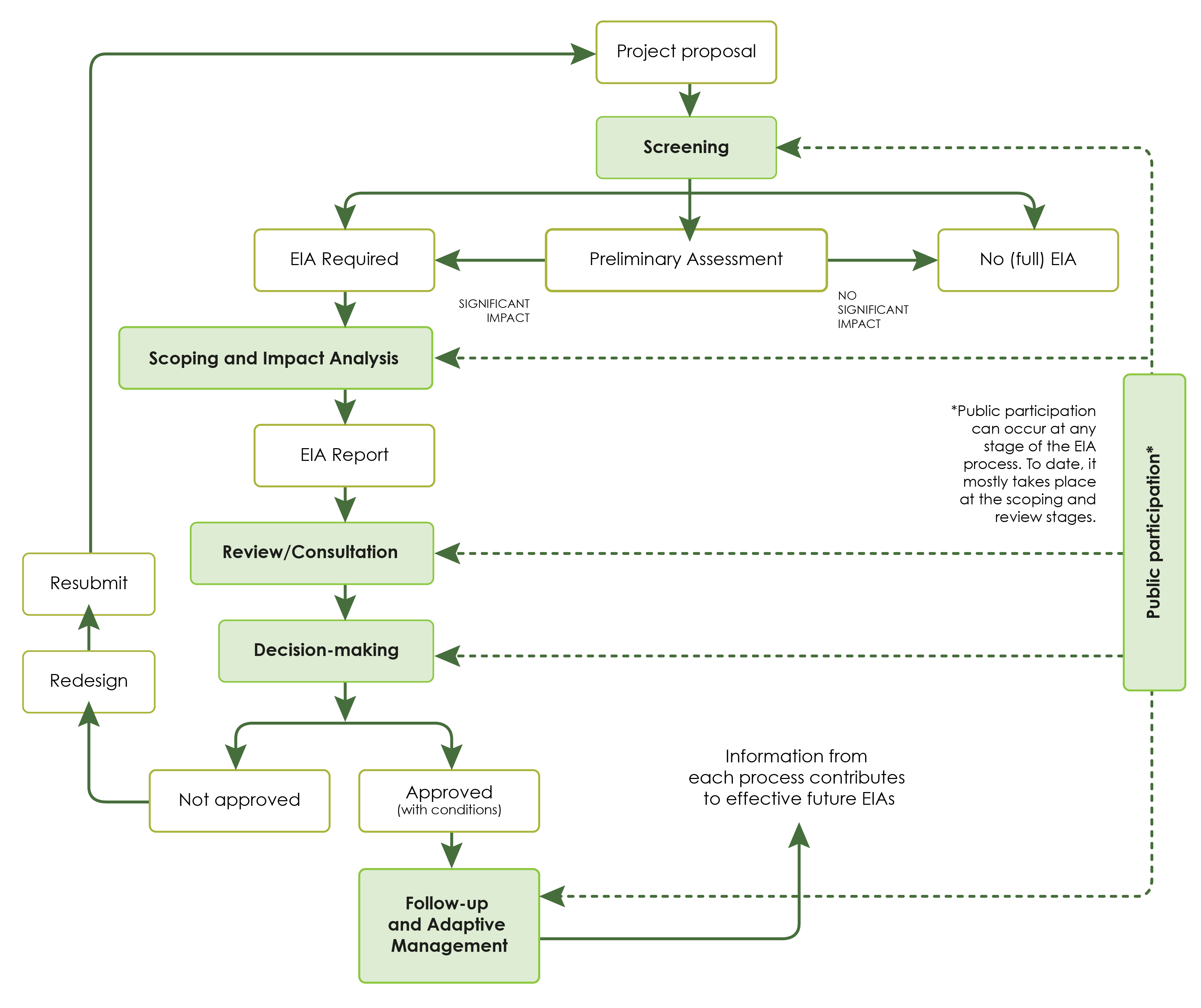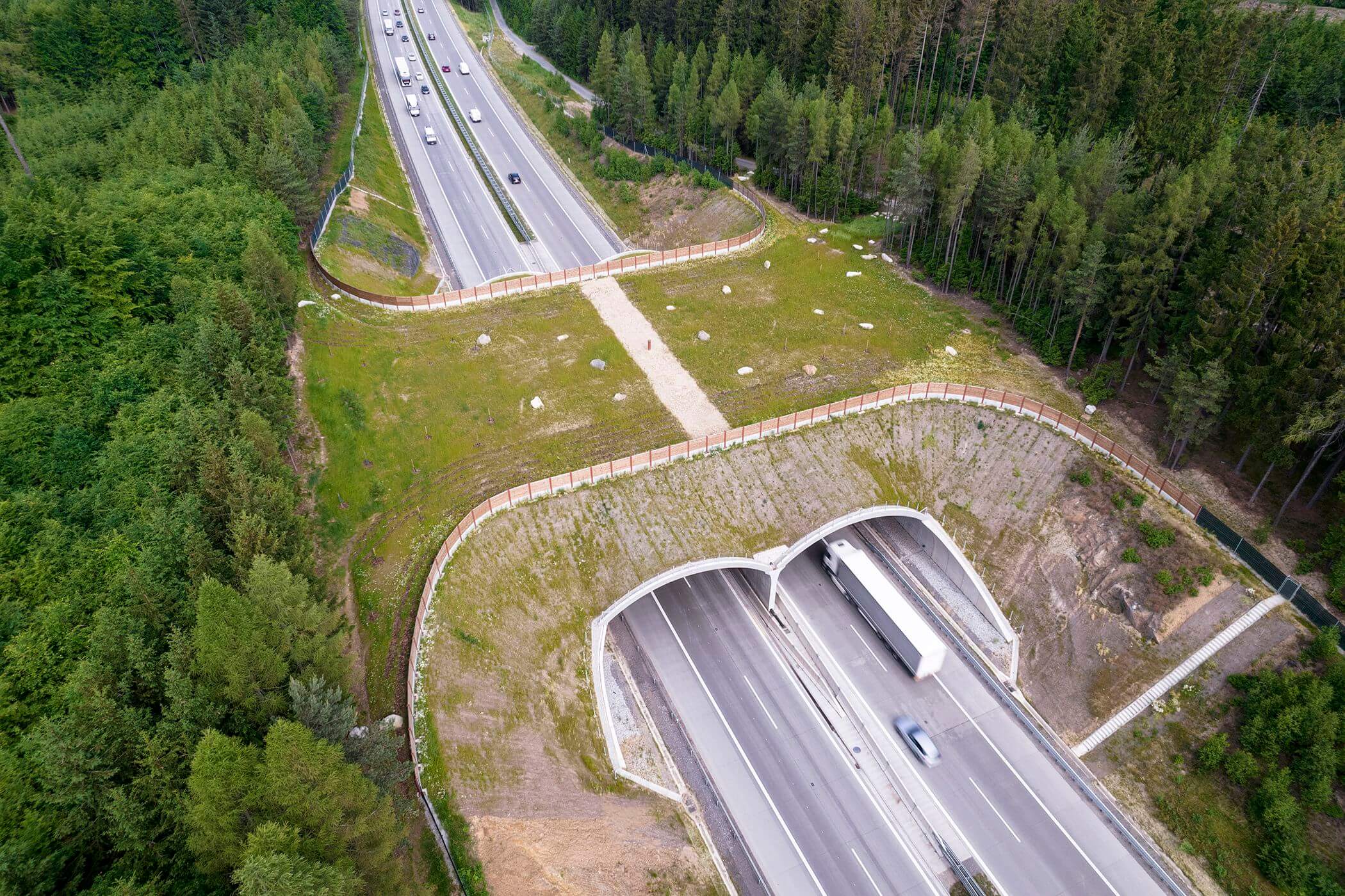Phase characteristics
The design phase starts after delimitation of the transport corridor is approved and a decision is made that allows construction preparation to start. The first subphase is the route/site selection (alignment), followed by a detailed project, contractor selection and a final building permit. During the design phase, parameters determining the potential impact of the project development on the environment, including effects on biodiversity and habitat fragmentation, are being assessed (Figure 2.3.1).
Design begins with the route/site selection. Different alternatives are prepared based on land use and topographic conditions. Proposals of the variants are assessed in detail based on socio-economic and environmental criteria and a final optimal route or site placement is selected. After that, confirmation of the route in land-use plans takes place. Each project then becomes gradually more specific as it advances through the next steps of the process. The chronological order of the process varies according to the legislation in individual countries. In some countries the next step after selecting the optime route is to prepare documentation for the land-use decisions and building permits and in selecting contractors (procurements). In other countries, selecting a contractor precedes a detailed implementation project, which is then agreed with the selected contractor.
Key issues to be addressed
During the design phase it is necessary to make some key decisions that determine the final impact of construction on biodiversity:
- Selecting a route/site variant with minimal impact on biodiversity
- Proposal of measures to avoid and reduce the impact of infrastructure on biodiversity (depending on the type/mode of infrastructure) and to restore any damage
- Proposal of compensation measures
- Monitoring plan to be undertaken during the construction and operation phases
- Plan of measures to protect biodiversity during construction
In this phase is crucial to apply the mitigation hierarchy (see Chapter 3 – The mitigation hierarchy). Avoiding the intersection of an important area by a transport alignment doesn’t conclude that connectivity issues are solved. Cohesion and connection of this area with the natural network of core areas, ecological corridors and linkages areas must be assessed and appropriate mitigation and/or compensation measures must be foreseen,
Key issues that should be addressed when planning particular types or modes of transport infrastructure are shown in Table 2.4.
Table 2.4 – Key issues to be addressed during the design of different types of transport infrastructure.
| Type of transport infrastructure | Key issues to be addressed during design phase to reduce the impact on biodiversity |
| All | Proposing measures to reduce potential negative impacts on biodiversity from direct, indirect and cumulative impacts. Start developing monitoring and evaluation plans to assess the efficiency of mitigation measures and allow flexibility in the design to apply corrective actions when measures are not working. |
| Roads and railways | Setting suitable location and dimensions parameters for wildlife passages, placement of fencing and escape ramps, artificial deterrents, warning and detection systems, planning of landscaping design on road verges including cuttings and embankments. Planning of compensatory measures, preparation of monitoring plan and fauna protection plan during construction is a standard part of design. Special attention must be paid to the design of measures to address the cumulative effect of multiple parallel barriers especially on pairing with other parallel linear infrastructure. |
| Powerlines | Minimizing habitat destruction under the powerlines. Planning of safe structures to avoid electrocution of birds landing on power poles. Identification of sections with a high risk of collisions and proposal of appropriate measures that make electrical wires visible to birds in flight. Planning for the integration of the powerline protection zone into ecological network. |
| Pipelines | Proposing measures to reduce habitat destruction. Proposal of further maintenance of the pipeline protection zone to enhance wildlife. |
| Waterways | Planning of natural banks allowing animals to cross canals, escape ramps, climb out of the water. For fish and other aquatic species, installation of passages at locks, creation of new wetland habitats (as compensation for destroyed habitats). Keeping a balance between water withdrawals and discharges. Maintaining environments threatened by hydro morphological modifications. Good management of incoming and outgoing flows of sediments |
| Ports | Avoiding destruction of wetlands and important aquatic freshwater and marine habitats. Creation of new wetlands with dredged sediments. Protecting animal species using ports as their habitat (water birds, seals, etc.). Allowing free movement of fish and other aquatic animals such as reptiles and mammals between the sea and the river, measures against the introduction of non-native species. Avoiding water pollution. |
| Airports | Avoiding the destruction and/or disturbance of valuable habitats (e.g. wetlands and grasslands). Considering avian migration corridors and migratory stopover sites. Reducing disturbance and risk of birds colliding with aircrafts. Creating and maintaining natural habitats in the airport protection zone. Set up Wildlife Hazard Management Programmes for mitigating bird collisions. |
Processes and tools
Several significant processes take place within the design phase. Different tools should be used to avoid, mitigate or compensate for the negative effects of planned transport infrastructure on biodiversity:
- Environmental Impact Assessment (EIA). This is the basic tool for managing project specific impacts and ensuring compliance with environmental requirements in this phase. The EIA process should begin in the route/site selection phase and should be complete within the final project. The start and end of the EIA process depends on the legislation in different countries. Figure 2.3.2 shows a generic EIA diagram for the process.
- Appropriate Assessment (AA) is a specific type of assessment for plans and projects significantly affecting Natura 2000 sites and required under Article 6 of the Habitats directive. An assessment on the effects for a Natura 2000 site must be undertaken for any plan for transport infrastructure development that can – individually or in combination with other plans – significantly influence the subject(s) of protection or integrity of the site.
- Integration of biodiversity targets (i.e., identify priorities for impact mitigation) for maintaining and restoring the quality of terrestrial, aquatic, and marine environments.
- Further evaluation of the impacts on biodiversity of a proposed project following requirements from national legislation of a particular country.
Common activities conducted in an EIA, AA and other evaluations of the impacts of a project proposal on fauna include:
- Biological survey: usually beginning during the alternative (variant) selection phase and worked out in detail for the final alternative is selected.
- Migration study: documenting in detail the terrestrial, aquatic or avian movements of all animal groups occurring in the construction area (based on the biological survey, available databases or data and in some cases obtained through ecological modelling), proposing measures to reduce fauna mortality, habitat fragmentation and obstruction of migration. Sporadic dispersion movements of specific species (large mammals) for long distances as well as the movements of migratory fish (eels, salmon, shad, etc.) when resolving the fragmentation of waterways should also be taken into account.
- Monitoring: carried out according to a monitoring plan, which is developed as part of the EIA process. During the design, the first part of the three-phase monitoring takes place (before construction – during construction – after construction) (see Chapter 6 – Evaluation and monitoring).
- Access: protecting access pathways to wildlife passages in land-use planning to avoid that subsequent urban or new infrastructure development could block the animal access to the wildlife passage.

